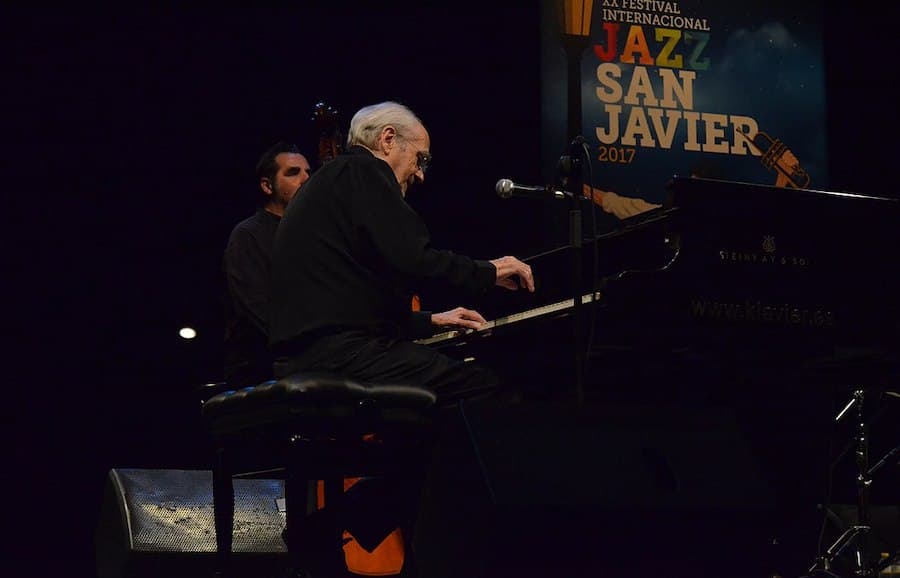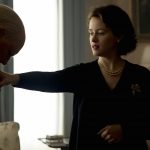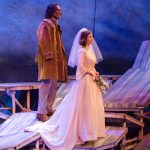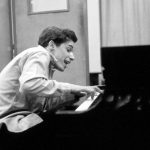In 1979 a critic for the New York Times confronted Michel Legrand with the criticism that his popular music was sentimental, “trite and treacly.” The occasion was the premiere of the off-Broadway adaptation of Jacques Demy’s film “The Umbrellas of Cherbourg,” with Legrand’s sung-dialogue score.
“I write what I feel,” Legrand shrugged, “and I write what I like.”
Legrand was then at the height of his commercial success, following scores and songs for “The Thomas Crown Affair,” “The Happy Ending,” “Summer of ’42,” and ABC television’s “Brian’s Song.” A partnership with Barbra Streisand would soon produce her directorial debut, the gender-bending musical “Yentl.”
Though Legrand’s trophy case was brimming with three Academy Awards, five Grammy Awards and one Emmy Award, he was also a fixture on Billboard’s Easy Listening chart and an easy target for critics.
Now, 40 years later, and following his death on January 26, 2019, Legrand’s reputation has broadened considerably (this July, the French Institute Alliance Française will present a Legrand film series at Florence Gould Hall on the Upper East Side). His mid-1960s breakthrough films with director Demy are recognized for their poignancy and ingenuity, and have influenced later pictures from Lars Von Trier’s “Dancer in the Dark” to Damien Chazel’s “La La Land.”
At the keyboard, Legrand’s jazz outings, from the 1959 LP “Legrand Jazz” (a star-bedecked session featuring Miles Davis and John Coltrane) to his 2001 quartet date at the Montreal Jazz Festival, have developed a genuine cult appeal, admired for their cross-pollination of American and French influences.
And although it’s the pop hits that stand out in Legrand’s film catalog, film historians have come to marvel at the expressive variety of his underscoring — cues featuring Baroque counterpoint, Stravinskian grit, jazz waltzes and tangos, sometimes all in a single scene. Worth noting that in 1976, he was dropped from director Richard Lester’s adventure film “Robin and Marian” because his proposed score was deemed too avant-garde, having taken the shape of a concerto for violin, cello and orchestra).
Jon Burlingame, who writes about film music for Variety and teaches at the University of Southern California, admires how these facets of Legrand’s work fed off one another.
“What I always loved about him,” says Burlingame, “was he not only had a way with jazz figures and jazz writing but found a way to make that work on screen. There are moments in ‘The Thomas Crown Affair,’ of 1968, that I just adore and are rooted in jazz but are essentially orchestral. Therefore they work in a filmic way. But he always found himself returning in one way or another to his classical training.”
Embracing Challenges
By the 1964 release of “The Umbrellas of Cherbourg” Legrand already had two decades of experience in music. Born in 1932 in the Paris suburb of Neuilly-sur-Seine, the child prodigy entered the Paris Conservatoire at age 11, studying with Nadia Boulanger, and graduating at age 19. He was dashing, a touch arrogant, and a “formidable seducer,” as one French newspaper recently put it (he married three times, most recently to the actor Macha Méril, in 2014).
After Legrand’s 1955 jazz orchestra album, “I Love Paris,” sold 8 million copies worldwide, his label pressured him to do an album about Vienna. His heart wasn’t in it, so he turned it into a satire — “Vienna Holiday” — “about waltzes that I hate.” Other big-band sessions followed including “Michel Legrand Plays for Dancers,” which he irreverently claimed was an effort to “destroy all of the violin orchestras.”
Around 1960, Legrand started practicing the piano for four hours a day, aiming to get his technique up to a level where he could perform Gershwin’s Rhapsody in Blue. The project never materialized, because, as he told the New York Times, ‘when I need a pianist, I know so many wonderful ones.’”
“Cherbourg” showed that Legrand could rise to a different challenge, of setting the entire dialogue of a film to music. The bittersweet score — tracing a love affair between Guy, a garage mechanic (Nino Castelnuovo) and Geneviève (Catherine Deneuve), a girl whose mother owns a struggling umbrella shop — is something entirely new, a kind of on-screen opera. Legrand once claimed that he spent a year composing music to Demy’s dialogue, and Demy occasionally reworked the lines to match Legrand’s themes. An actor and a singer were assigned to each role and the entire film was dubbed (Legrand’s sister, Christiane Legrand, sang the role of the mother).
Though many film critics grimaced at the film’s sweetly conventional plot, they may have failed to notice its rich musical fabric. In its recitative-like passages the score reflects the influence of vocalese groups including Lambert, Hendricks and Ross and Les Double Six of Paris. The central songs — “Watch What Happens” and “I Will Wait for You” — generate leitmotifs that illuminate the shifting moods of longing and regret. And the opening scene, set in the garage, has the feel of a rollicking big band suite, followed later by passages of tango and mambo rhythms.
And just as the score moves between arias and recitative, the visuals are united with bold, saturated colors in the sets and wardrobe. As Oxford University music lecturer Matthew Cheung Salisbury recently noted on Twitter, “Cherbourg” was 1964’s “premier Gesamtkunstwerk,” referring to Richard Wagner’s concept for a “total work of art.”
A Move to Hollywood
Less celebrated but arguably as influential is Demy and Legrand’s 1967 picture, “The Young Girls of Rochefort,” a whimsical confection with splashy outdoor production numbers and crisp jazz arrangements. The film yielded “Chanson de Maxence,” which has been covered by numerous performers, including Steinway Artist Brad Mehldau and mezzo-soprano Anne Sofie von Otter. (The melody, paired with new English-language lyrics by Alan and Marilyn Bergman, became the song “You Must Believe in Spring.”)
In an e-mail, Mehldau praised Legrand’s “very strong melodies and harmonies that go deep yet have a fundamental simplicity that you hear in the great songwriters. There’s a clear story to the music.” Mehldau especially admires the way Legrand uses harmonic cycles, “creating constant tension and resolution.”
In 1966 Legrand moved to Hollywood, where his friends and fellow composers Henry Mancini and Quincy Jones introduced him to the lyricists Alan and Marilyn Bergman. He’d go on to pen dozens of songs with the Bergmans including “The Windmills of Your Mind,” from 1968’s “The Thomas Crown Affair.” The ornate melody, hypnotically intoned by Noel Harrison, perfectly matched the moody tale of an enigmatic playboy thief, played by Steve McQueen. Other Legrand-Bergman songs outlasted the films in which they appeared. “What Are You Doing the Rest of Your Life?”, from “The Happy Ending” (1969), became a standard covered by pianists Oscar Peterson, George Shearing, and Bill Evans.
“He could write melodies faster and better than virtually anybody before or since,” says Burlingame, who notes that Legrand would also boldly reimagine his older songs. Burlingame cites the Grammy-winning 1972 album, “Sarah Vaughan with Michel Legrand.” “I remember buying that LP, and getting home and putting it on the turntable and thinking, ‘My God, he’s rethought all his own stuff for Sarah Vaughan and it’s just as great as it was the first time around.’”
Legrand’s talent for the unending melody was matched by the Frenchman’s flair for orchestration, which took on a modernist edge in several of his scores. “The Thomas Crown Affair” began as a kind of an independent jazz symphony, which Legrand then cut to fit the film’s individual scenes. The seductive chess match between McQueen and Faye Dunaway’s characters used sultry jazz strings and bright splashes of guitar, piano and harpsichord.
Even more audaciously, Legrand developed a series of jazz-orchestral cues for “The Picasso Summer” (1969), an otherwise problematic film about a San Francisco couple that travels to France in search of Pablo Picasso (an extended animated sequence evokes Stravinsky). And in 1970, Legrand delivered a trippy neoclassical score for Demy’s “Peau d’Âne” (Donkey Skin), a fairytale musical with echoes of “Cherbourg.”
In 1971 Legrand won his first and only Oscar for Best Original Score with the coming-of-age film, “Summer of ’42,” one of more than a dozen awards the blockbuster film received. Its four-note, minor-key theme is a relentless earworm — sweetly melancholic, with lush string arrangements and tinkly piano elaborations.
It’s true that Legrand didn’t always choose his film projects effectively, and though he won three Oscar nominations for “Yentl,” including Best Original Score, the Streisand vehicle has its detractors. As The New York Times noted, “The songs… constitute an ongoing interior monologue for [protagonist] Yentl, but they have been slapped so awkwardly onto the narrative at times — with Yentl sometimes singing over other characters’ dialogue — that they neither advance nor amplify the action.” Legrand later called the project “exhausting,” and sought to moved on by next writing music for the 1983 James Bond film “Never Say Never Again.”
Custodian of a Grand Song Tradition
Streisand was one of dozens of prominent singers to interpret Legrand’s work, a list that includes Tony Bennett, Ray Charles, Neil Diamond, Ella Fitzgerald, Peggy Lee, Lena Horne, Johnny Mathis, Liza Minnelli, Frank Sinatra, Sting, and opera singers Kiri Te Kanawa and Jessye Norman. Some of these projects featured Legrand himself, either conducting or at the piano, and in this sense, he became something of a custodian of the formal Hollywood song tradition.
In later years Legrand continued to push himself, whether it meant learning how to pilot a plane or writing symphonic works for the concert hall. Conductor Raymond Harvey led the premiere of Legrand’s Concerto for Piano and Orchestra in 2016, with the composer joining the Kalamazoo Symphony Orchestra.
“He was a delightful man and still a marvelous pianist, even at that advanced age,” Harvey recalls. “The rehearsal process was congenial but also very detailed.” He adds: “The piece has a little bit of everything: thorny sections, brilliant little piano cadenzas, overtly lyrical moments, a grand theme in last movement.”
Legrand also took on greater cultural stature in later years. In 2016 he was named a commander in the Legion d’honneur, France’s highest honor. “He was a great cross-cultural presence between American and France,” said Marie-Monique Steckel, the president of the French Institute Alliance Française. “He wanted to be part of the music world both in America and France. He had a whole French education but then fell in love with jazz and American music.”
And Steckel sums up a common refrain about Legrand: that whether it was his pioneering film scores, his jazz performances, or his concert-hall work, he exuded a zest for life. Legrand turned reflective in a 2018 interview with The Guardian.
“Every movie that I’ve scored,” Legrand said, “I’ve tried to be original, to be different from what we’re used to listening to. When I write music, my music talks. It’s not a music that says nothing, a tapestry where nothing happens, like most of the composers. I think I’ve been an adventurer – in life, in my work, too.”
Top photo: Michel Legrand at the Festival Internacional de Jazz de San Javier, 2017 (Photo by Tsaorin/Wikipedia Commons)
This article also appears at Steinway.com.








Leave a Reply